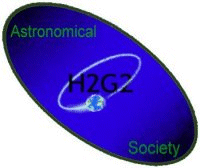Heads Up
Created | Updated Apr 9, 2013
Welcome to the






Established 10th August 2000
| h2g2as Front Page | The main site page. |
| Moonwatching | The page for Lunartics. |
| h2g2as Q and A | Find the answers to many space related questions. |
| Astronomy Links | Find all the best astronomy links as well as links to local societies. |
| Heads Up | What's to see in the coming month. |
| Members Page | Meet the many researchers who have joined the h2g2as and join yourself. |
| Babe Among the Stars | Galaxy Babe's column in The Post. |

Calendar of Meteor Showers
Most of the major meteor showers occur at or around the same time every year. The following is a handy list of some of the big ones, along with the approximate date listed for peak activity. It should be remembered that the meteors per hour figure is an approximation based on past showers' activity. Actual results may vary.
| Date | Meteor Shower | Meteors Per Hour |
|---|---|---|
| January 3 | Quadrantids | 40 |
| April 21 | Lyrids | 15 |
| May 4 | Eta Aquarids | 20 |
| July 28 | Delta Aquarids | 20 |
| August 12 | Perseids | 50 |
| October 21 | Orionids | 25 |
| November 3 | South Taurids | 15 |
| November 17 | Leonids | 15 |
| December 13 | Geminids | 50 |
| December 22 | Ursids | 15 |
The Messier Marathon
Charles Messier, astronomer to the French court of King Louis XV produced a list of objects observable in the night sky that were to be avoided so that they would not be confused with his main pre-occupation, comets. The Messier list contains 110 objects that perversely are some of the most interesting objects in the night sky and are definitely not comets. During the latter part of March each year, all 110 are observable between dusk and dawn during the course of a single night. This year, 2009, many dedicated Marathoners tried their luck during the weekend of 28/29 March, but here at H2 we tend to be a bit more flexible. You you can start your own marathon to run as long as you want it to. To set your own time limit to view the famous 110 just start a convo there and we'll record the running total as you go along.
Measurements in the Sky
From time to time, we make describe the distance between objects in the sky in degrees. Here's a quick rule of thumb guide to help you understand what we're talking about:
- The sky is 180 degrees from horizon to horizon. A degree can further be divided into 60 arcminutes and an acrminute can be divided into 60 arcseconds.
- For reference, both the Sun and the Full Moon are each half a degree, or 30 arcminutes in diameter.
- At arm's length, the distance across the knuckles of a clenched fist covers 10 degrees.
- The stars in Ursa Major which point toward Polaris (the North Star) are 5 degrees apart.
Share Your Wisdom
Check out the Department of Astronomy as part of a great collaborative effort at the h2g2 University. There are a lot of great entries being written there on a variety of astronomical topics. The idea behind the University project is to create subtopics of information in a broader category - like Astronomy. And to do so in a specified time period. Everyone is invited so stop by!
Fight Light Pollution
Why not ask your local zoning authority if there are any restrictions on light pollution where you live. Bright parking lot lights will eventually fill the night sky with a dull haze of background light, ruining the chances of seeing the stars! To join the fight to save dark skies, go the International Dark Sky Association.
If you don't think there's a light pollution in your area, go outside and look at the Big Dipper.1 You should see a double star in the handle, second star up from the end. That is Alcor and Mizar. If you can't see them, you either need glasses or you've got a light pollution problem!
Join the fight - turn off that outside light!
Join the H2G2 Astronomy Society
H2G2 Astronomy Society which carries the latest astronomical news as well as linking to many of the astronomical entries on h2g2. It's also a great place to hang out and chat with fellow Researchers about astronomical topics which interest you.
Search for Extraterrestrial Intelligence
Are we alone in the universe?
Who knows, but now, you can join the search for extraterrestrial life with a few dozen guide researchers who have joined together to help the SETI team. For more information you can go to the h2g2 SETI@home page.
Picture of the Day
You can click on this link to find the NASA Picture of the Day. This link is pretty cool - in addition to an interesting astronomical photo, there is a brief explanation of what you're seeing. American tax dollars at work!
Check out the BBC's pages
BBC Online's Space pages, including a 3-D tour of the Solar System, a user submitted photo gallery, a quiz and up-to-date news. It's definitely worth checking out! UK license fees at work!
